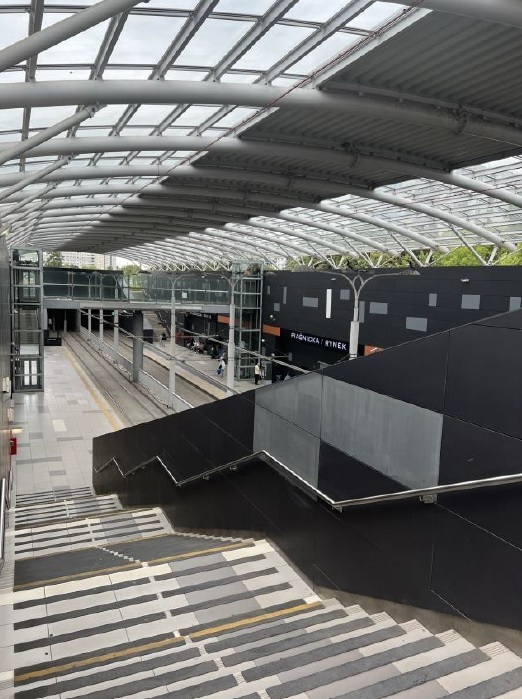RESEARCH PAPER
Modeling the accessibility of public transport to people with disabilities in the GTFS standard
1
Politechnika Poznańska, Polska
Submission date: 2023-11-04
Final revision date: 2023-12-03
Acceptance date: 2023-12-05
Online publication date: 2023-12-06
Publication date: 2023-12-28
Corresponding author
Rail Vehicles/Pojazdy Szynowe 2023,3-4,47-53
KEYWORDS
TOPICS
ABSTRACT
In this paper, the possibility of using the GTFS standard to describe the public transport (PT) stop infrastructure in Poland, was evaluated. It was also proposed to expand the existing GTFS file of the ZTM (PT authority) in Poznań to include a detailed description of a selected two-level tram stop. A testbed equipped with open source software was built and used for this purpose. The study showed that despite the fact that in Poland, PT organizers and operators do not provide detailed information on its accessibility to people with disabilities, the preparation of such information is possible, while modifications to the data generated so far may be required, especially regarding the stops. However, the preparation and updating of this data on a nationwide scale may pose a problem.
FUNDING
Research work was carried out as part of the projects:
(1) Analysis of the scale of transport exclusion in Poland together with recommendations of legislative changes in the context of public transport (GOSPOSTRATEG-V/0005/2021) financed by the National Center for Research and Development under the Strategic Program for Scientific Research and Development “Social and economic development of Poland in the conditions of globalizing markets” – GOS-POSTRATEG;
(2) Shaping transport systems in the context of environmental needs (0416/SBAD/0004).
REFERENCES (24)
1.
Ashraf MT, Dey K, Carrola A, Shi X. Impacts of real-time transit information on transit accessibility – A case study. J Public Transport. 2023;25:100043. https://doi.org/10.1016/j.jpub....
2.
Bar K, Bieńczak M, Rychlewski J, Walerjańczyk W, Zmuda-Trzebiatowski P. Ocena standardów informacji pasażerskiej w zakresie dostępności dla osób ze szczególnymi potrzebami. In: Annały Inżynierii Ruchu i Planowania Transportu. Poznań, Rosnówko: SITK RP. 2023: 99-112.
3.
Bezyak JL, Sabella SA, Gattis RH. Public transportation: an investigation of barriers for people with disabilities. J Disabil Policy Stu. 2017;28(1):52-60. https://doi.org/10.1177/104420....
4.
Burkhard R, Schooley B, Horan TA. Public use of an online advanced traveler guidance information system: trust in the e-service and the agency. Journal of International Technology and Information Management. 2013;22(2):1-18. https://doi.org/10.58729/1941-....
5.
Davies DK, Stock SE, Holloway S, Wehmeyer ML. Evaluating a GPS-based transportation device to support independent bus travel by people with intellectual disability. J Intellect Dev Dis. 2010;48(6):454-463. https://doi.org/10.1352/1934-9....
6.
Dziekan K, Kottenhoff K. Dynamic at-stop real-time information displays for public transport: effects on customers. Transport Res A-Pol. 2007;41(6):489-501. https://doi.org/10.1016/j.tra.....
7.
Hansson J, Pettersson F, Svensson H, Wretstrand A. Preferences in regional public transport: a literature review. Eur Transp Res Rev. 2019;11(1):38. https://doi.org/10.1186/s12544....
15.
Jeremicz P. Pokazać komunikacje publiczna wszystkim pasażerom to pokazanie jej w pierwszej kolejności osobom niewidomym. IV Ogólnopolska Konferencja Naukowo-Techniczna „Transport Kolejowy Przeszłość – Teraźniejszość – Przyszłość”. Warszawa: Urząd Transportu Kolejowego; 2021. 83-96.
16.
Koperski Ł, Zmuda-Trzebiatowski P. Ocena stanu infrastruktury przystankowej. Studium przypadku: poznański Łazarz. Prace naukowe Politechniki Warszawskiej. Transport. 2018;121:181-190.
17.
Kowalski K. Planowanie dostępności – polskie uwarunkowania prawne i praktyka. Niepełnosprawność–zagadnienia, problemy, rozwiązania. 2013;1(6):71-99.
18.
Leng N, Corman F. The role of information availability to passengers in public transport disruptions: an agent-based simulation approach. Transport Res A-Pol. 2020;133:214-236. https://doi.org/10.1016/j.tra.....
19.
Lucas K. Transport and social exclusion: where are we now? Transport Policy. 2012;20:105-113. https://doi.org/10.1016/j.tran....
20.
Mulley C, Clifton GT, Balbontin C, Ma L. Information for travelling: Awareness and usage of the various sources of information available to public transport users in NSW. Transport Res A-Pol. 2017;101:111-132. https://doi.org/10.1016/j.tra.....
21.
Strug B, Ślusarczyk G. Reasoning about accessibility for disabled using building graph models based on BIM/IFC. Vis in Eng. 2017;5(1):10. https://doi.org/10.1186/s40327....
22.
Van Lierop D, Badami MG, El-Geneidy AM. What influences satisfaction and loyalty in public transport? A review of the literature. Transport Rev. 2018;38(1):52-72. https://doi.org/10.1080/014416....
23.
Yeboah G, Cottrill CD, Nelson JD, Corsar D, Markovic M, Edwards P. Understanding factors influencing public transport passengers’ pre-travel information-seeking behaviour. Public Transp. 2019;11(1):135-158. https://doi.org/10.1007/s12469....
24.
Zmuda-Trzebiatowski P., Bar K., Bieńczak M.: Adoption of digital public transport information in Poland. Prace Komisji Geografii Komunikacji PTG; 2023;22(2):7-21.
Share
RELATED ARTICLE
We process personal data collected when visiting the website. The function of obtaining information about users and their behavior is carried out by voluntarily entered information in forms and saving cookies in end devices. Data, including cookies, are used to provide services, improve the user experience and to analyze the traffic in accordance with the Privacy policy. Data are also collected and processed by Google Analytics tool (more).
You can change cookies settings in your browser. Restricted use of cookies in the browser configuration may affect some functionalities of the website.
You can change cookies settings in your browser. Restricted use of cookies in the browser configuration may affect some functionalities of the website.




